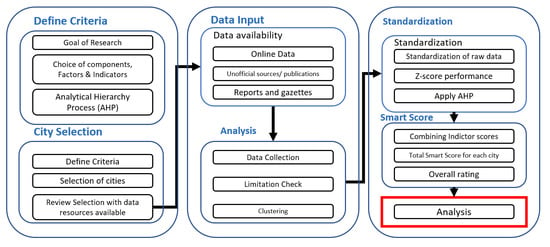Smart City Ranking System: A Supporting Tool to Manage Migration Trends for Australian Cities
Abstract
:1. Introduction
1.1. The Concept of Smart Cities and Rankings
1.2. Australian Regional Cities
1.3. Research Questions
“Whether the smart city/preferred city ranking processes can be considered as an effective indicator for human capital attraction within Australian context?”
2. Literature Review
2.1. Different Ranking Systems
2.2. Choice of Indicators and Weightages
2.3. Missing Data Issue for Small Cities
3. Smart City Ranking of Australian Regional Cities
- Ranking criteria;
- City selection;
- Data collection;
- Data processing;
- City ranking scores;
- Analysis.
3.1. Ranking Criteria
3.1.1. Ranking Goals
3.1.2. Ranking Parameters
- Governance is defined by the decision-making and public services of stakeholders. Being an essential component for smart city plan, it allows for citizens to keep the decision and implementation process clear.
- Economy is a component that influences multiple factors to improve a city, including business life, faster ways to locate business services, participate in urban development, increase GDP, and creating jobs.
- Environment is designed to improve the sustainability by considering clean energy, clean air, and clean waterfront. Conditions to contribute a smart environment is by decreasing the air pollution, water pollution, and CO2 emissions.
- Livability is entailed to improve the lives of the people. It allows for people to have a better health care, safety, quality of housing, social cohesion, and other activities in society.
- Mobility relates to the movement of people and good around the cities. Safe transportation system and ICT accessibility are essential to allow people to get from one place to another.
- People are the ones who can create an economy, education system, and transportation. Though multiple indicators such as level of education, academic, and technical degrees and additional training, as well as the ability to communicate in multiple language for the social harmony of the society.
3.2. City Selection
3.3. Data Collection
3.4. Data Processing
3.4.1. Imputation of Missing Data
3.4.2. Data Standardization
- z = Smart Score
- = Output
- = Mean
- = Standard Deviation
3.5. City Ranking Score
Analytical Hierarchy Process (AHP)
4. Performance Analysis
4.1. Overall Performance
4.2. Performance at the Component Level
4.3. Detailed Analysis of States
5. Conclusions and Recommendations
Author Contributions
Funding
Conflicts of Interest
Appendix A
| Indicators | Data Source | |
|---|---|---|
| New Businesses/Total | GCCSA | Economy and Industry |
| Large Businesses/Total | GCCSA | Economy and Industry |
| Self Employed Trend | GCCSA | Economy and Industry |
| Total Businesses Trend | GCCSA | Economy and Industry |
| Patent & Trademark Apps Trend | portal.aurin.org.au | Patent applicants & Trademark applicants |
| Business Entry Rate Trend | GCCSA | Economy and Industry |
| Building Approvals Trend | GCCSA | Economy and Industry |
| Dwelling Worth | GCCSA | Economy and Industry |
| PSHouse Worth/Dwelling | GCCSA | Economy and Industry |
| Gross Product/Cap | 41,020 Eco.Indicators | Table 2 |
| Wage Price Index WPI | 41,021 Eco.Indicators | Table 3 |
| Unemployment Rate TrendInversed | GCCSA | Education and Employment |
| Gross Capital Gains mil Trend | portal.aurin.org.au | gcg reportd by taxpayers |
| Pensions/Allowances Trend | GCCSA | Income |
| Sports&Rec mil | 4147 Gov Funding | Page 10 |
| Total Assistance Trend | GCCSA | Income |
| Enrolled Voters | aec.gov.au | Actual enrollement |
| Votes HOReps | 13,700 Trust | Table 2 |
| Votes Senate | 13,700 Trust | Table 2 |
| Community Incentive | Social Survey | Table 3.3 (A81) |
| Community Programs | Social Survey | Table 3.3 (A112) |
| Renewable Energy by | Renewable Energy By State | Page 6 |
| Net Zero emissions by | Renewable Energy By State | Page 6 |
| Air Quality week average | breezometer.com | breezo meter |
| C Equivalent TrendInversed | Australia Progress | Table 11 |
| GreenHouse Gas Emi Trend Inversed | 13,700 Sustain Enviro | Table 1.2 |
| Aquatic Biota Index Inversed | 4614 Aus Enviro Issue | Page 6 |
| River Enviro Index | 4614 Aus Enviro Issue | Page 7 |
| Water Development | Australia Progress | Table 9 |
| Expenditure Per Capita | 46,110 Enviro Protection | Page 11 |
| Expenditure Per Capita | 46,110 Enviro Mgmt | Page 18 |
| Solar Installations Trend | GCCSA | Land and Environment |
| Solar Hot Water Trend | GCCSA | Land and Environment |
| Suburbs w/> 50% solar Installs | Renewable Energy By State | Page 4 |
| Solar Households | pv-map.apvi.org.au | Mapping Australian Photovoltaic installations |
| Capacity/Capita No hydro kW/Cap | Renewable Energy By State | Page 4 |
| Renewable Electricity | Renewable Energy By State | Page 4 |
| Median Sale Price Trend Inversed | GCCSA | Economy and Industry |
| Rent Inversed | GCCSA | Family and Community |
| Mortgage Inversed | GCCSA | Family and Community |
| Mortgage <30% Income | GCCSA | Family and Community |
| Rent < 30% Income | GCCSA | Family and Community |
| Person/Household | GCCSA | Family and Community |
| + Beds needed | GCCSA | Family and Community |
| Employed Percentage | GCCSA | Education and Employment |
| Participation Rate | GCCSA | Education and Employment |
| Unemployment Rate | GCCSA | Education and Employment |
| Assault | 41,020 Other | Table 2 |
| Break-ins | 41,020 Other | Table 2 |
| Safe Travel Home | Social Survey | A174 |
| + Crimes/yr | Social Survey | A187 |
| Private Health Trend | GCCSA | Health And Disbaility |
| Male Life Expectancy | 3302055001DO002_2017-2019 Life tables | Table 2.1 |
| Female Life Expectancy | 3302055001DO002_2017-2019 Life tables | Table 2.1 |
| Excellent Self Health | Social Survey | A133 |
| Median Income | GCCSA | Income |
| Mean Income | GCCSA | Income |
| Disposable Income weekly mid | portal.aurin.org.au | median disposable household income synthetic estimates |
| 1000–2000% | GCCSA | Income |
| Train Network | Each States Satisfaction In. | Satisfaction Index |
| Bus Network | Each States Satisfaction In. | Satisfaction Index |
| Taxi | Each States Satisfaction In. | Satisfaction Index |
| Utilization to work/study | ATTA—Transport by State | Table 2.2 |
| Utilization outside of work/study | ATTA—Transport by State | Table 2.7 |
| Train-Tram to Work | GCCSA | Family and Community |
| Bus to Work | GCCSA | Family and Community |
| Roads | 13,700 Built Environment | Table 1 |
| Car Acc/, ppl Inverse | 41,020 Health Indicator | Table 2 |
| Car to Work | GCCSA | Family and Community |
| Population Density/km | GCCSA | Population and People |
| Cars/ppl | GCCSA | Economy and Industry |
| Av Distance to Work/Study | GCCSA | Family and Community |
| Multiple to Work | GCCSA | Family and Community |
| Computer/Household | 41020 Other | Table 2 |
| Internet Connectivity | GCCSA | Family and Community |
| Science/Technical Services | GCCSA | Economy and Industry |
| Post School Qualified | GCCSA | Education and Employment |
| BA Degree | GCCSA | Education and Employment |
| Above BA Degree | Social Survey | A253 |
| Managers | GCCSA | Education and Employment |
| Professionals | GCCSA | Education and Employment |
| Technicians | GCCSA | Education and Employment |
| Languages Spoken | GCCSA | Population and People |
| Library Visits | Social Survey | A122 |
| Art and Museum Visits | Social Survey | A122 |
| Cultural Tolerance | Social Survey | A154 |
| Bike to work | GCCSA | Family and Community |
| Walk to work | GCCSA | Family and Community |
| Enrolled Voters | 13,700 Participation | Table 1 |
| Organized Sport | 41,020 Other | Table 2 |
References
- Sun, H.S.Y.; Jara, A.J.; Bie, R. Internet of Things and Big Data Analytics for Smart and Connected Communities. IEEE Access 2016, 4, 766–773. [Google Scholar] [CrossRef]
- Prakash, A. Smart Cities Mission in India: Some definitions and considerations. Smart Sustain. Built Environ. 2019, 8, 322–337. [Google Scholar] [CrossRef]
- de Jong, S.J.M.; Schraven, D.; Zhan, C.; Weijnen, M. Sustainable-smart-resilient-low-carbon-eco-knowledge cities; Making sence of a multitude of concepts promoting sustainable urbanization. J. Clean. Prod. 2015, 109, 3–25. [Google Scholar] [CrossRef] [Green Version]
- Liotine, M.; Ramaprasad, A.; Syn, T. Managing a Smart City’s resilience to Ebola: An ontological framework. In Proceedings of the 2016 49th Hawaii International Conference on System Sciences (HICSS), Koloa, HI, USA, 5–8 January 2016. [Google Scholar]
- Pries-Heje, J.; Cranefield, J. Smart Leadership for Smart Cities: A Leadership Role Framework. Roskilde University 2018. Available online: https://forskning.ruc.dk/en/publications/smart-leadership-for-smart-cities-a-leadership-role-framework (accessed on 12 March 2020).
- Batten, J. Sustainable Cities Index 2015. Arcadis 2015. Available online: https://www.arcadis.com/media/E/F/B/%7BEFB74BBB-D788-42EF-A761-4807D69B6F70%7D9185R_Arcadis_whitepaper_2015.pdf (accessed on 12 March 2020).
- Wey, W.-M.; Ching, C.-H. The Application of Innovation and Catapult Research Techniques to Future Smart Cities Assessment Framework. In Proceedings of the 2018 International Conference on System Science and Engineering (ICSSE), Tokyo, Japan, 28–29 May 2018. [Google Scholar]
- Kuru, K.; Ansell, D. TCitySmartF: A Comprehensive Systematic Framework for Transforming Cities into Smart Cities. IEEE Access 2020. [Google Scholar] [CrossRef]
- Angelidou, M. Smart Cities: A Conjuncture of Four Forces; Elsevier Ltd.: Amsterdam, The Netherlands, 2015. [Google Scholar]
- Escolar, S.; Villanueva, F.J.; Santofimia, M.J.; Villa, D.; del Toro, X.; López, J.C. A Multiple-Attribute Decision Making-based approach for smart city rankings design. Elsevier 2018, 142, 42–55. [Google Scholar] [CrossRef]
- Guerra, M. What exactly is a smart city? Electron. Des. 2017, 19, 20. [Google Scholar]
- Pardo, N. Conceptualizing Smart City with Dimension of Technology, People and Institutions. In Proceedings of the 12th Annual International Digital Government Research Conference: Digital Government Innovation in Challenging Times, Atlanta, GA, USA, 12–15 June 2011. [Google Scholar]
- Albino, V.; Beradi, U.; Dangelico, R.M.; Berardi, U.; Dangelico, R.M. Smart Cities: Definitions, dimensions, performance, and initiatives. Urban Technol. 2015, 22, 3–21. [Google Scholar] [CrossRef]
- Allam, Z.; Newman, P. Redefining the Smart City: Culture, Metabolism and Governance. Smart Cities 2018, 1, 2. [Google Scholar] [CrossRef] [Green Version]
- Capeluto, I.G.; Ben-Avraham, O.; Isaac, O.B.-A.; Capeluto, G. Assessing the green potetial of existing buildings towards smart cities and districts. Indoor Built Environ. 2015, 25, 1124–1135. [Google Scholar] [CrossRef]
- Poole, S. The Guardian. 2014. Available online: https://www.theguardian.com/cities/2014/dec/17/truth-smart-city-destroy-democracy-urban-thinkers-buzzphrase (accessed on 12 March 2020).
- Yigitcanlar, T.; Kankanamge, N.; Vella, K. How Are Smart City Concepts and Technologies Perceived and Utilized? A Systematic Geo-Twitter Analysis of Smart Cities in Australia. J. Urban Technol. 2020, 1–20. [Google Scholar] [CrossRef]
- Damion, K.V.; Bunders, J. Problematizing data-driven urban practices: Insights from five Dutch ‘smart cities. Cities 2019, 93, 145–152. [Google Scholar]
- General Electronics; Smart City. 2015. Available online: http://www.gegridsolutions.com/alstomenergy/grid/microsites/grid/products-andservices/ (accessed on 12 March 2020).
- Yigitcanlar, T.; Kamruzzaman, M.; Buys, L.; Ioppolo, G.; Sabatini-Marques, J.; da Costa, E.M.; Yun, J.J. Understanding ‘smart cities’: Intertwining development drivers with desired outcomes in a multidimensional framework. Cities 2018, 145, 160. [Google Scholar]
- The Economist. Hotspot 2025, Benchmarking of the Future Competiveness of Cities; The Economist Intelligence Unit Limited: London, UK, 2013. [Google Scholar]
- Department of Economic and Social Affairs, Population Division. World Urbanization; Department of Economic and Social Affairs, Population Division: New York, NY, USA, 2019. [Google Scholar]
- Lopes, I.M.; Oliveira, P. Can a small city be considered a smart city? In Procedia Computer Science; Elsevier B.V.: Amsterdam, The Netherlands, 2017; Volume 121. [Google Scholar] [CrossRef]
- Herrschel, T. Competitiveness AND Sustainability: Can ‘Smart City Regionalism’ Square the Circle? Urban Stud. 2013, 50, 2332–2348. [Google Scholar] [CrossRef]
- Yigitcanlar, T.; Kamruzzaman, M. Smart Cities and Mobility: Does the Smartness of Australian Cities Lead to Sustainable Commuting Patterns? J. Urban Technol. 2019, 26. [Google Scholar] [CrossRef]
- Macke, J.; Casagrande, R.M.; Sarate, J.A.R.; Silva, K.A. Smart city and quality of life: Citizens’ perception in a Brazilian case study. J. Clean. Prod. 2018, 182, 717–726. [Google Scholar] [CrossRef]
- Palmisano, S.J. A Smarter Planet: The Next Leadership Agenda. IBM 2008, 6, 1–8. [Google Scholar]
- Graham, B.; Tennant, M.; Shiikha, Y.; Kruger, E. Distribution of Australian private dental practices: Contributing underlining sociodemographics in the maldistribution of the dental workforce. Aust. J. Prim. Health 2019, 25. [Google Scholar] [CrossRef]
- Daley, J.; Wood, D.; Chivers, C. Regional Patterns of Australia’s Economy and Population; Grattan Institute: Melbourne, Australian, 2017. [Google Scholar]
- Connell, J. Rural Change in Australia: Population, Economy, Environment; Routledge: Boca Raton, FL, USA, 2016. [Google Scholar]
- Hugo, G. Immigrant settlement outside of Australia’s capital cities. Popul. Space Place 2008, 14. [Google Scholar] [CrossRef]
- Hugo, G. Changing Patterns of Population Distribution in Australia. J. Popul. Res. 2002, 2001, 1–21. [Google Scholar]
- 3218.0—Regional Population Growth, Australia, 2016–2017. Available online: https://www.abs.gov.au/ausstats/abs@.nsf/Lookup/3218.0main+features952016-17 (accessed on 12 March 2020).
- C. Statistics, o=Commonwealth of Australia, and ou=Australian B. Of 2071.0-Census of Population and Housing: Reflecting Australia-Stories from the Census. ABS 2016. Available online: https://www.abs.gov.au/ausstats/abs@.nsf/Lookup/by%20Subject/2071.0~2016~Main%20Features~Aboriginal%20and%20Torres%20Strait%20islander%20Population%20Article~12 (accessed on 12 March 2020).
- Australian Demographic Statistics, June 2016. 2017. Available online: http://www.abs.gov.au/AUSSTATS/abs@.nsf/Lookup/3101.0Main+Features1Jun2016?OpenDocument (accessed on 12 March 2020).
- Parr, A. Understanding the motivations for return migration in Australia. Aust. Popul. Stud. 2019, 3. [Google Scholar] [CrossRef]
- Giles, L.C.; Halbert, J.A.; Gray, L.C.; Cameron, I.D.; Crotty, M. The distribution of health services for older people in Australia: Where does transition care fit? Aust. Health Rev. 2009, 33, 572–582. [Google Scholar] [CrossRef] [Green Version]
- Alam, K. Determinants of access to eHealth services in regional Australia. Int. J. Med. Inform. 2019, 131, 103960. [Google Scholar] [CrossRef]
- Borsellino, R. The changing migration patterns of the 65+ population in Australia, 1976–2016. Aust. Popul. Stud. 2020, 4. [Google Scholar] [CrossRef]
- Freeman, J.; Hancock, L. Energy and communication infrastructure for disaster resilience in rural and regional Australia. Reg. Stud. 2017, 51, 933–944. [Google Scholar] [CrossRef]
- wa Mungai, N.; Priestly, J.; Pawar, M. Food Insecurity in Regional Rural Australia. Aust. Soc. Work 2020, 73, 149–161. [Google Scholar] [CrossRef]
- Argent, N.; Tonts, M.; Jones, R.; Holmes, J. The Amenity Principle, Internal Migration, and Rural Development in Australia. Ann. Assoc. Am. Geogr. 2014, 104. [Google Scholar] [CrossRef]
- Argent, N.; Tonts, M.; Jones, R.; Holmes, J. A creativity-led rural renaissance? Amenity-led migration, the creative turn and the uneven development of rural Australia. Appl. Geogr. 2013, 44, 88–98. [Google Scholar] [CrossRef]
- Rolfe, J.; Kinnear, S.; Borg, D. Factors affecting population and workforce mobility in Australia: A future of declining regional affinity? Rural Soc. 2020, 29, 1–15. [Google Scholar] [CrossRef]
- Argent, N.; Walmsley, J. Rural youth migration trends in Australia: An overview of recent trends and two inland case studies. Geogr. Res. 2008, 46. [Google Scholar] [CrossRef]
- Hon, T.; Tudge, A.; The Department of Infrastructure, Transport, Regional Development and Communications. Smart Cities and Suburbs Program. Available online: https://www.infrastructure.gov.au/cities/smart-cities/ (accessed on 12 March 2020).
- McManus, P.; Connell, J. Putting places on the map? Marketing rural and regional Australia. J. Destin. Mark. Manag. 2014, 3, 105–113. [Google Scholar] [CrossRef]
- Anholt, S. Place branding: Is it marketing, or isn’t it? Place Brand. Public Dipl. 2008, 4, 1–6. [Google Scholar] [CrossRef]
- Anholt, S. Editorial: Should place brands be simple. Place Brand. Public Dipl. 2009, 5, 91–96. [Google Scholar] [CrossRef]
- Lenihan, H.; McGuirk, H.; Murphy, K.R. Driving innovation: Public policy and human capital. Res. Policy 2019, 48, 103791. [Google Scholar] [CrossRef]
- Wang, L.; Guo, B.; Yang, Q. Smart City Development with Urban Transfer Learning. IEEE 2018, 51, 32–41. [Google Scholar] [CrossRef]
- Garcia-Font, V.; Garrigues, C.; Rifa-Pous, H. Difficulties and challenges of Anomaly Detection in Smart Cities: A Labortory Analysis. Sensors 2018, 18, 3198. [Google Scholar] [CrossRef] [Green Version]
- O’Brien, J. 5 Australian Cities Battle for ‘Smart City’ Glory. CIO 2018. Available online: https://www.cio.com.au/article/646152/5-australian-cities-battle-smart-city-glory/ (accessed on 30 October 2018).
- Anthopoulos, L.G.; Fitsilis, P. Smart cities and their roles in city competition: A classification. Int. J. Electron. Gov. Res. 2014, 10. [Google Scholar] [CrossRef] [Green Version]
- Onnom, W.; Tripathi, N.; Nitivattanonon, V.; Ninsawat, S. Development of a Liveable City Index (LCI) Using Multi Criteria Geospatial Modelling for Medium Class Cities in Developing Countries. Sustainability 2018, 10, 520. [Google Scholar] [CrossRef] [Green Version]
- MORI Memorial Foundation. Global Power City IndeX. 2019. Available online: http://mori-m-foundation.or.jp/english/ius2/gpci2/index.shtml (accessed on 13 November 2020).
- Wu, Z. Intelligent City Evaluation System; Springer: Singapore, 2018. [Google Scholar]
- Tariq, M.A.U.R.; Faumatu, A.; Hussein, M.; Shahid, M.L.U.R.; Muttil, N. Smart City-Ranking of Major Australian Cities to Achieve a Smarter Future. Sustainability 2020, 12, 2797. [Google Scholar] [CrossRef] [Green Version]
- Giffinger, R.; Gudrun, H. Smart cities ranking: An effective instrument for the positioning of cities? ACE Archit. City Environ. 2010, 4, 7–25. [Google Scholar]
- Lee, J.H.; Phaal, R.; Lee, S.-H. An integrated service-device-technology roadmap for smart city development. Technol. Forecast. Soc. Chang. 2013, 80, 286–306. [Google Scholar] [CrossRef]
- Mohanty, S.; Choppali, U.; Kougianos, E. Everything you wanted to know about smart cities. IEEE 2016, 5, 60–70. [Google Scholar]
- Liu, F.; Shi, Y.; Chen, Z. Smart City Ranking Reliability Analysis. In Proceedings of the 2018 International Conference on Computational Science and Computational Intelligence (CSCI), Las Vegas, NV, USA, 13–15 December 2018. [Google Scholar]
- Benamrou, B.; Mohamed, B.; Bernoussi, A.-S.; Mustapha, O. Ranking models of smart cities. IEEE 2016, 51, 72–79. [Google Scholar]
- Munier, N. Methodology to select a set of urban sustainability indicators to measure the state of the city, and performance assessment. Ecol. Indic. 2011, 11, 1021–1026. [Google Scholar] [CrossRef]
- Klopp, J.M.; Petretta, D.L. The urban sustainable development goal: Indicators, complexity and the politics of measuring cities. Cities 2017, 63, 92–97. [Google Scholar] [CrossRef]
- Dias, D.; Amorim, J.H.; Sá, E.; Borrego, C.; Fontes, T.; Fernandes, P.; Pereira, S.R.; Bandeira, J.; Coelho, M.C.; Tchepel, O. Assessing the importance of transportation activity data for urban emission inventories. Transp. Res. Part D Transp. Environ. 2018, 62, 27–35. [Google Scholar] [CrossRef]
- Dizdaroglu, D. Developing micro-level urban ecosystem indicators for sustainability assessment. Environ. Impact Assess. Rev. 2015, 54, 119–124. [Google Scholar] [CrossRef]
- Sassen, S. The Global City: New York, London, Tokyo; Princeton, N.J., Ed.; Princeton University Press: Oxford, UK, 2001. [Google Scholar]
- Khan, N.U.; Wan, W.; Yu, S. Spatiotemporal Analysis of Tourists and Residents in Shanghai Based on Location-Based Social Network’s Data from Weibo. Int. J. Geo Infor. 2020, 9, 70. [Google Scholar] [CrossRef] [Green Version]
- Yadav, P.K.; Gupta, S.; Kumar, D. Machine performance index (MPI): A method to evaluate the performance of mining dumper. J. Mines Met. Fuels 2019, 67, 320–325. [Google Scholar]
- Bernardon, D.P.; Sperandio, M.; Garcia, V.J.; Canha, L.N.; Abaide, A.D.R.; Daza, E.F.B. AHP decision-making algorithm to allocate remotely controlled switches in distribution networks. IEEE Trans. Power Deliv. 2011, 26, 1884–1892. [Google Scholar] [CrossRef]
- McArthur, J.; Moonen, T. Liveable Cities Rankings: How a Global Enterprise Is Influencing Urban Change. 2019. Available online: https://theconversation.com/liveable-cities-rankings-how-a-global-enterprise-is-influencing-urban-change-113948 (accessed on 12 March 2020).
- Xiangrui, C.; Gang, K.; Tie, L.; Yi, P. Jie Ke versus AlphaGo: A ranking approach using decision making method for large-scale data with incomplete information. Eur. J. Oper. Res. 2017, 265, 239–247. [Google Scholar]
- Rana, N.P.; Luthra, S.; Mangla, S.K.; Islam, R.; Roderick, S.; Dwivedi, Y.K. Barriers to the Development of Smart Cities in Indian Context. Inf. Syst. Front. 2018, 21, 503–525. [Google Scholar] [CrossRef] [Green Version]
- Wang, X.; Chi, C. Global city indicator: Towards a holistic view of low carbon city dimensions. Energy Procedia 2016, 88, 168–175. [Google Scholar] [CrossRef] [Green Version]
- Zhao, Z.; Cerf, S.; Birke, R.; Robu, B.; Bouchenak, S.; Mokhtar, S.B.; Chen, L.Y. Robust Anomaly Detection on Unreliable Data. In Proceedings of the 2019 49th Annual IEEE/IFIP International Conference on Dependable Systems and Networks (DSN), Portland, OR, USA, 24–27 June 2019. [Google Scholar]
- Dopazo, E.; Martinez-Cespedes, M.L. Rank aggregation methods dealing with incomplete information applied to Smart Cities. In Proceedings of the 2015 IEEE International Conference on Fuzzy Systems (FUZZ-IEEE), Istanbul, Turkey, 2–5 August 2015. [Google Scholar]
- Chi, J.T.; Chi, E.C.; Baraniuk, R.G. k-POD: A Method for k-Means Clustering of Missing Data. Am. Stat. 2016, 70. [Google Scholar] [CrossRef] [Green Version]
- Souto, M.C.P.D.; Jaskowiak, P.A.; Costa, I.G. Impact of missing data imputation methods on gene expression clustering and classification. BMC Bioinform. 2015, 16, 1–9. [Google Scholar] [CrossRef] [PubMed] [Green Version]
- Boluki, S.; Dadaneh, S.Z.; Qian, X.; Dougherty, E.R. Optimal clustering with missing values. BMC Bioinform. 2019, 20, 1–10. [Google Scholar] [CrossRef] [PubMed] [Green Version]
- Carr, C. Inside Smart Cities—Place, Politics and Urban Innovation; Routledge: London, UK, 2019; Volume 55. [Google Scholar] [CrossRef]
- List of Cities in Australia by Population. Wikipedia. 2020. Available online: https://simple.wikipedia.org/wiki/List_of_cities_in_Australia_by_population (accessed on 12 November 2020).
- Wilson, S.E. Methods for Clustering Data with Missing Values. no. December, 2015. Master’s Thesis, Mathematical Institute Statistical Science for the Life and Behavioural Sciences, University of Leiden, Leiden, The Netherlands.



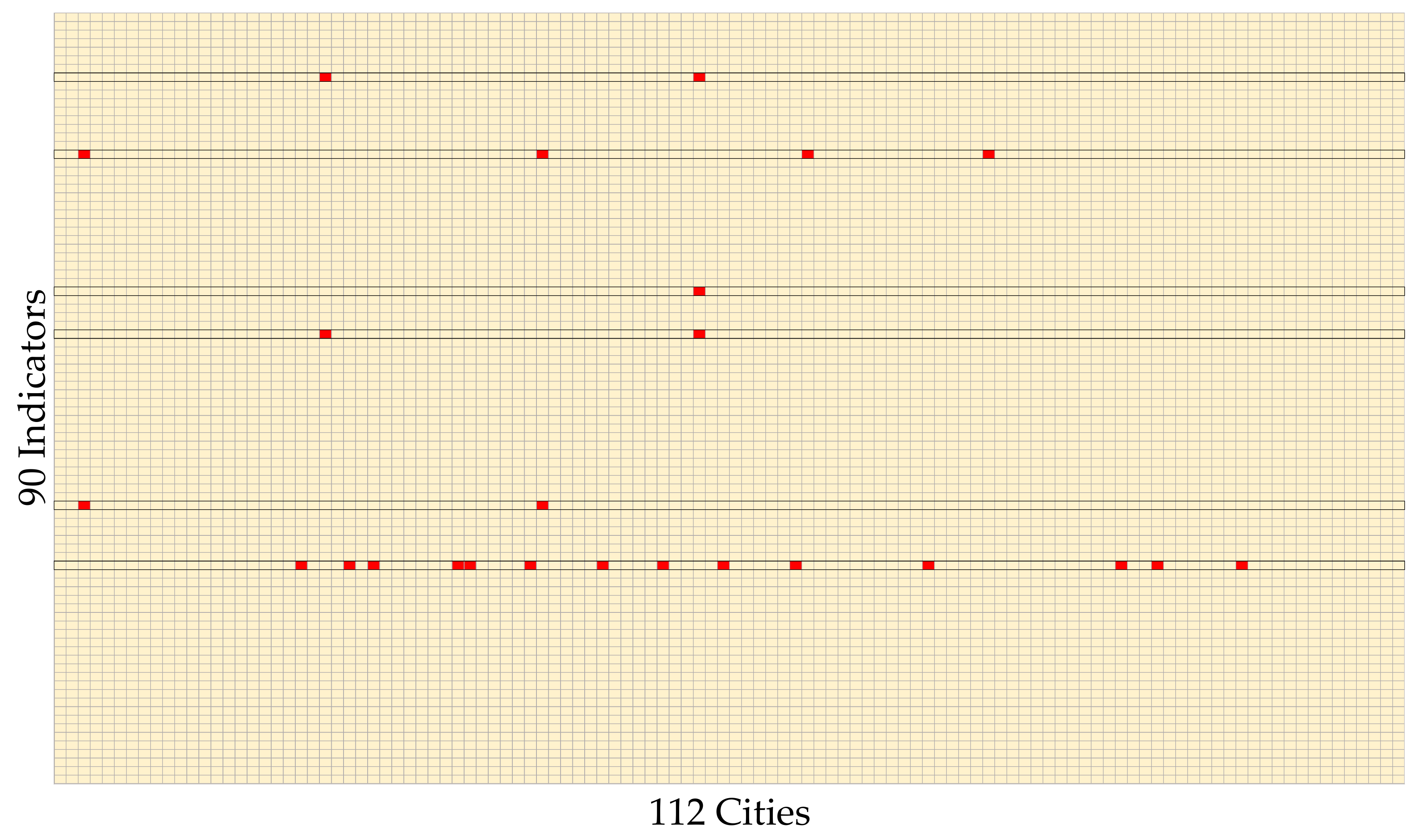

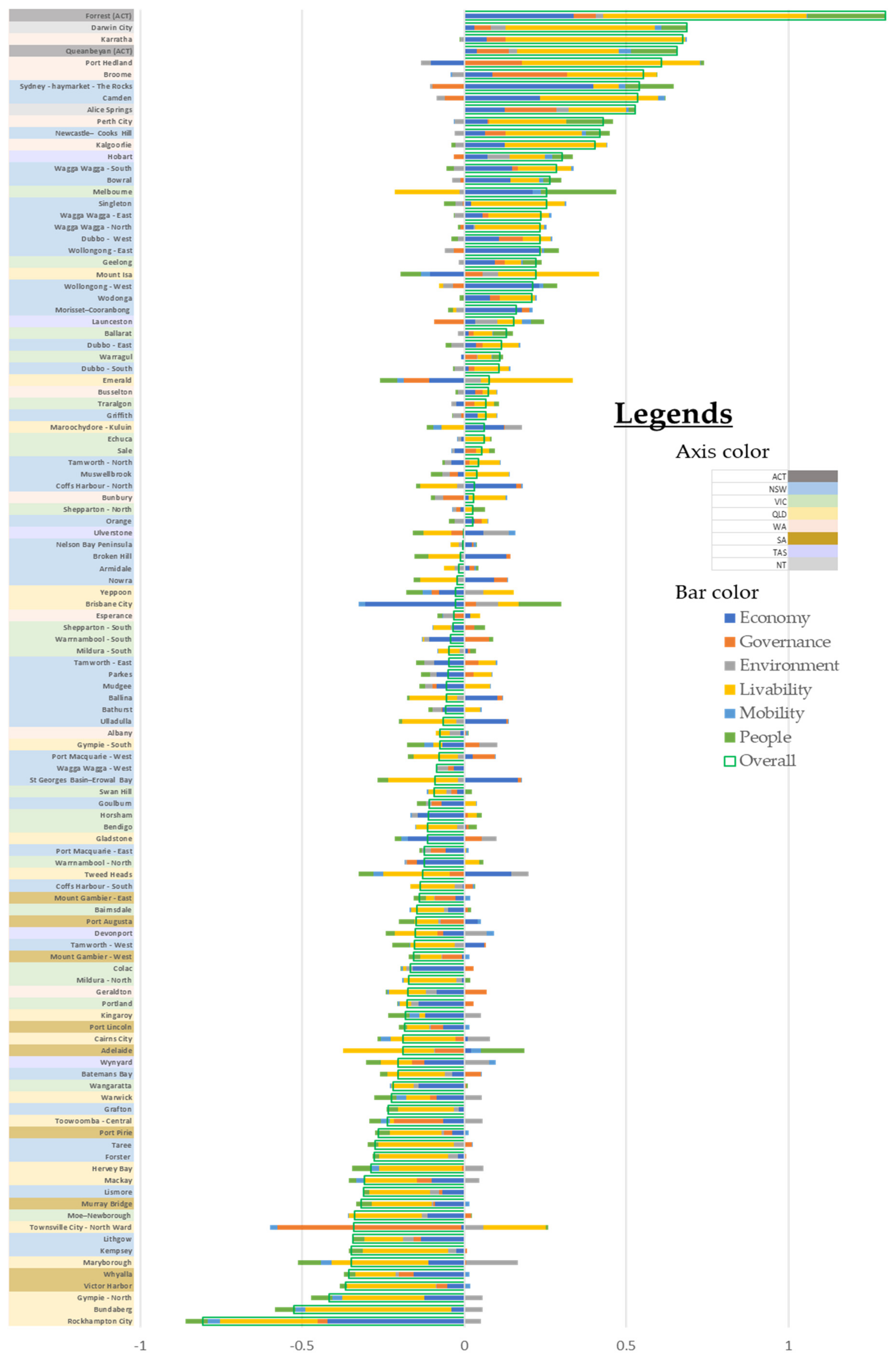



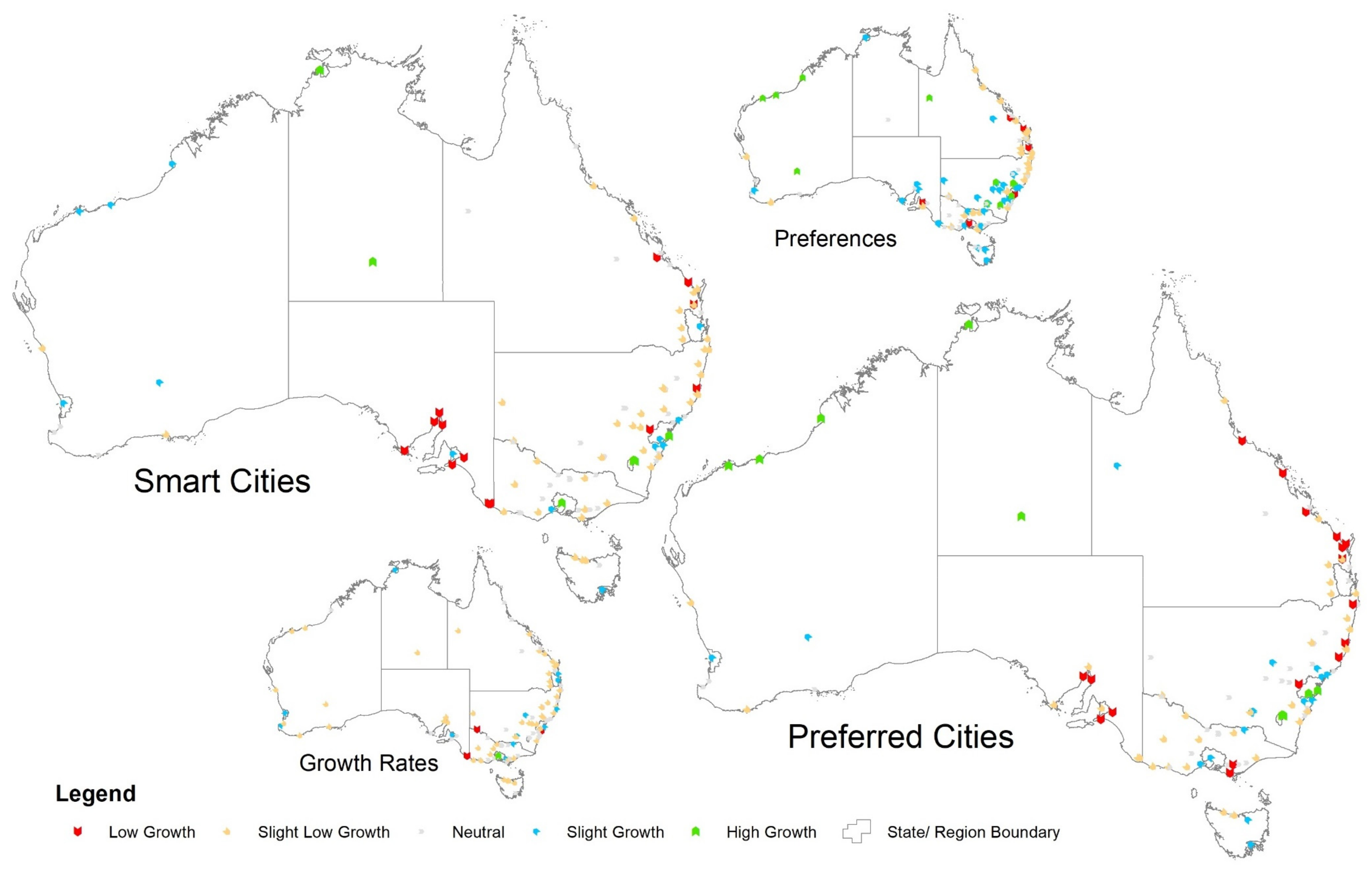
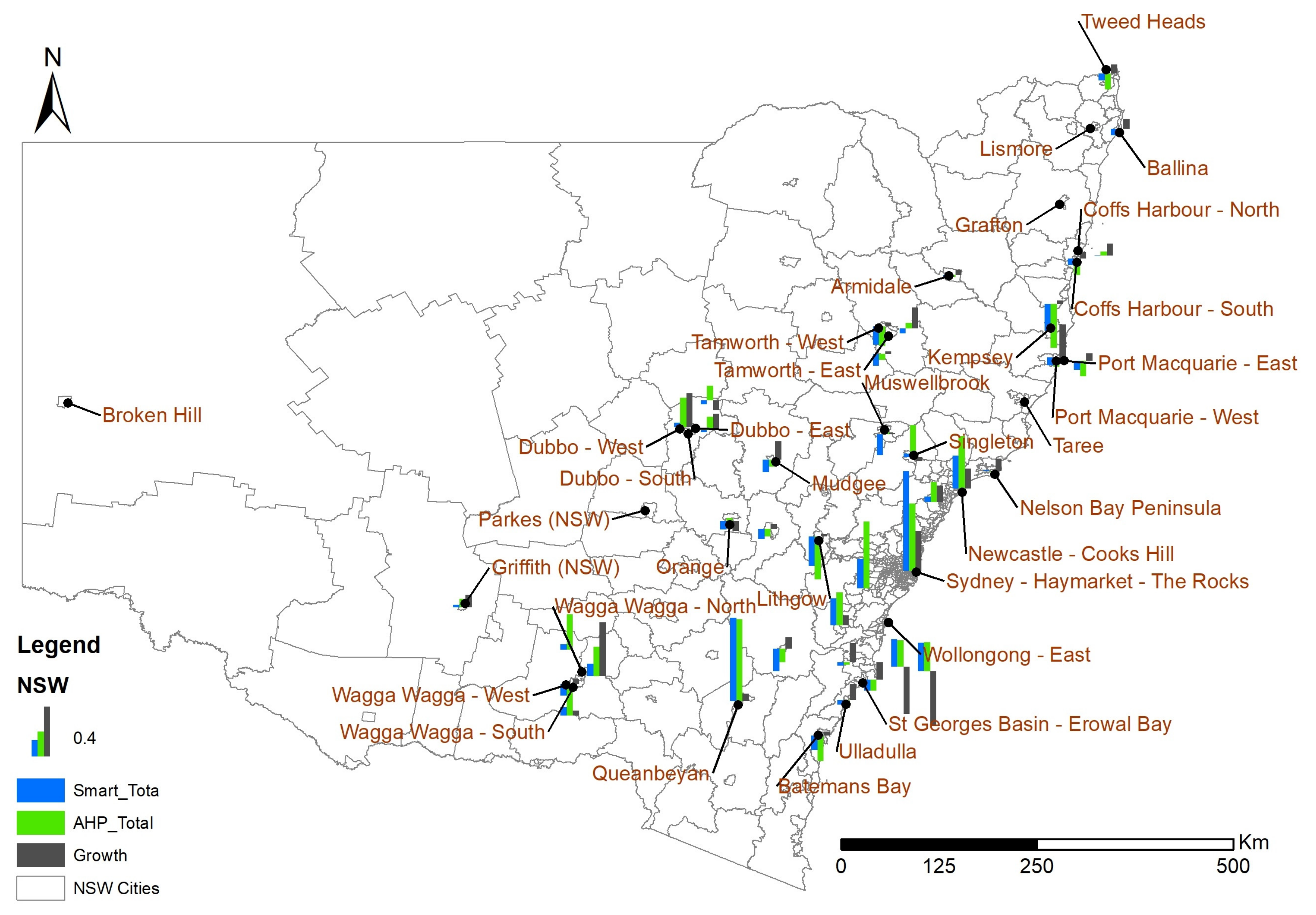


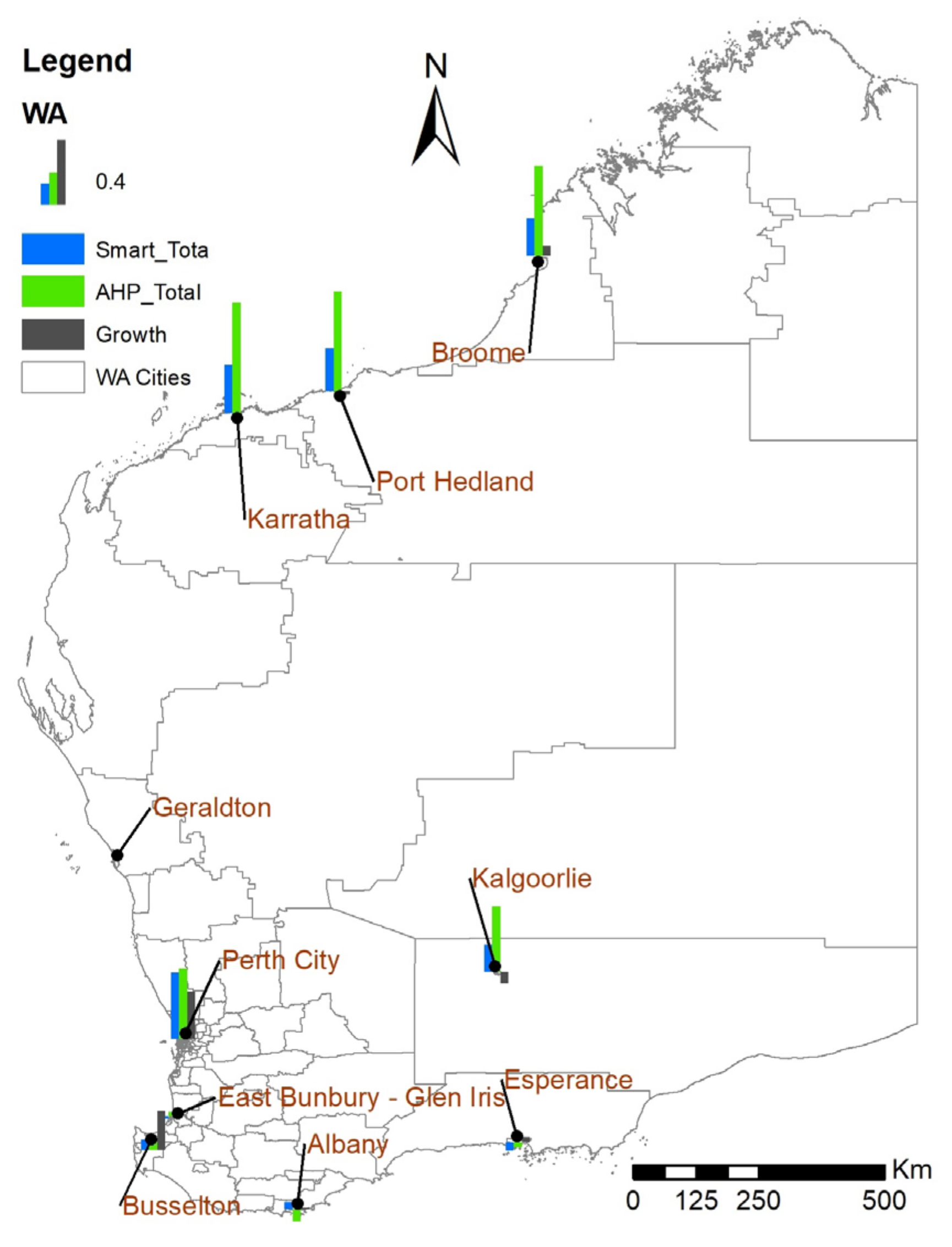
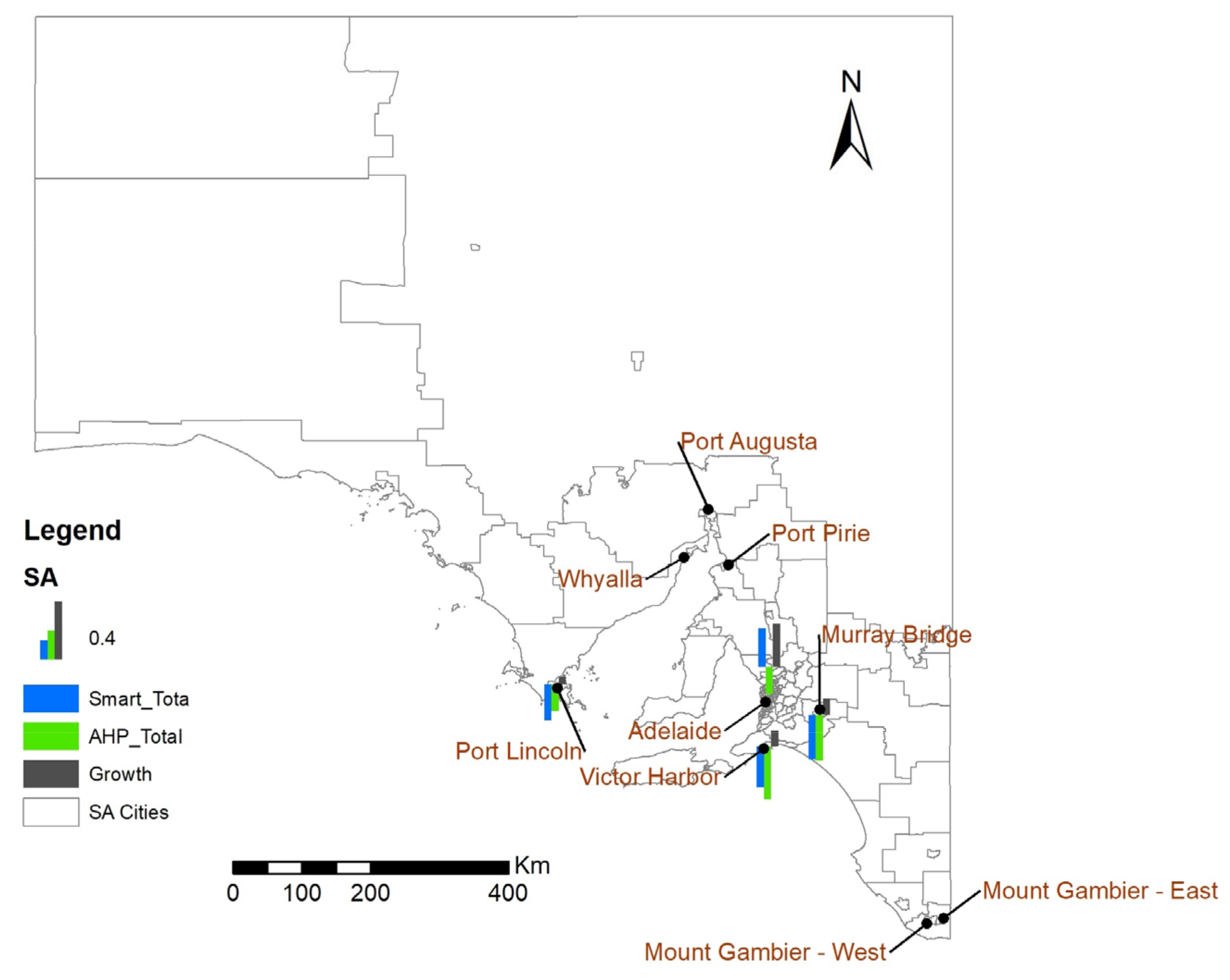

| Criteria | Description | Range |
|---|---|---|
| 1 | Total population | >10,000 < 700,000 |
| 2 | Population density | >50 person/km2 |
| 3 | Statistical Area Level | Statistical Area 2 |
| 4 | Limit on Greater Cities | Not more than one SA−2 from each greater city |
| Type of Data | Coverage Level |
|---|---|
| 1410.0—Data by Region, 2013–2018 | Statistical Area 2 |
| Disposable income 2011 | Statistical Area 2 |
| Patent & Trademark Apps 2015–2016 | Statistical Area 3 |
| Gross Capital Gains, 2015–2016 | Statistical Area 3 |
| Life expectancy at birth 2017–2019 | Statistical Area 4 |
| Greater Capital City Statistics | Greater Capital City Statistical Area |
| Number of Indicators | Coverage Level Used |
|---|---|
| 47 | Statistical Area 2 |
| 1 | Statistical Area 3 |
| 2 | Statistical Area 4 |
| 40 | Greater Capital City Statistical Area |
| 90 | Total |
| Quantitative Importance | Qualitative Description |
|---|---|
| 1/9 | Not important |
| 1/7 | |
| 1/5 | Less important |
| 1/3 | |
| 1 | Equally important |
| 3 | Important |
| 5 | |
| 7 | Extremely important |
| 9 |
Publisher’s Note: MDPI stays neutral with regard to jurisdictional claims in published maps and institutional affiliations. |
© 2021 by the authors. Licensee MDPI, Basel, Switzerland. This article is an open access article distributed under the terms and conditions of the Creative Commons Attribution (CC BY) license (http://creativecommons.org/licenses/by/4.0/).
Share and Cite
Tariq, M.A.U.R.; Hussein, M.; Muttil, N. Smart City Ranking System: A Supporting Tool to Manage Migration Trends for Australian Cities. Infrastructures 2021, 6, 37. https://doi.org/10.3390/infrastructures6030037
Tariq MAUR, Hussein M, Muttil N. Smart City Ranking System: A Supporting Tool to Manage Migration Trends for Australian Cities. Infrastructures. 2021; 6(3):37. https://doi.org/10.3390/infrastructures6030037
Chicago/Turabian StyleTariq, Muhammad Atiq Ur Rehman, Maha Hussein, and Nitin Muttil. 2021. "Smart City Ranking System: A Supporting Tool to Manage Migration Trends for Australian Cities" Infrastructures 6, no. 3: 37. https://doi.org/10.3390/infrastructures6030037
APA StyleTariq, M. A. U. R., Hussein, M., & Muttil, N. (2021). Smart City Ranking System: A Supporting Tool to Manage Migration Trends for Australian Cities. Infrastructures, 6(3), 37. https://doi.org/10.3390/infrastructures6030037







